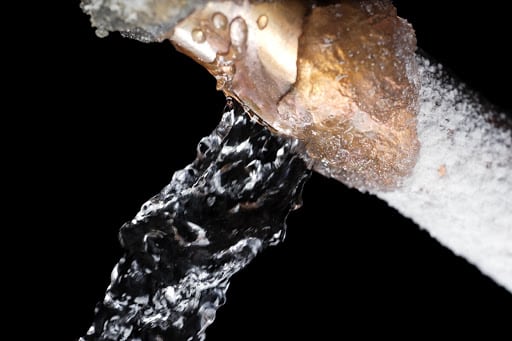Preparing Your Pipes For Winter Weather

Taking measures to keep your pipes warm can save you the headache and cost of dealing with burst pipes. Burst pipes are one of the most common causes of property damage during frigid weather and can cause thousands of dollars in water damage. We may not have many below freezing days in Lakeway, but insurance companies report more claims from burst pipes in warm-weather climates since pipes are often not adequately insulated.
Drain Pipes versus Water Pipes
Pipes only freeze if they are pressurized and left susceptible to freezing temperatures. When this water freezes, it expands, pushing pressure down the pipe, which can lead to a burst pipe. The pipes that carry water out (wastewater) of your home are not usually susceptible to freezing, so the pipe connected to your drains need not be insulated. Uninsulated water pipes (those carrying potable/drinking water into your home) in uninsulated spaces are most at risk to freezing, however even water pipes running through cabinets or exterior walls can freeze. Water pipes must be adequately protected along their entire length.
Temperature Alert Threshold
For the most susceptible of uninsulated pipes, research conducted by the Building Research Council at the University of Illinois shows that the “temperature alert threshold” is 20 degrees Fahrenheit. This does not mean pipes cannot freeze before reaching this mark. Consider wind chill when assessing the risk factor, which can make the pipes cool faster, but will not cause the pipes to cool below the actual air temperature. However, significant wind can cause cold temperatures to invade even the smallest of cracks forcing the cold air into perceived insulated spaces.
How to Prevent Pipes from Freezing
Prevention is key to protecting your home’s valuable plumbing infrastructure against damage during the winter season.
Your most susceptible pipes will be found:
- in exterior walls (usually bathrooms and kitchen sinks)
- on the exterior of the home
- in unheated areas (attics, crawl spaces, garage)
Consumer Reports recommends a few simple steps you can take to prevent pipes from freezing inside your home:
- Keep garage doors closed, especially if there are water supply lines in the garage.
- Open kitchen and bathroom cabinet doors to allow warmer air to circulate around the plumbing, especially if your sinks are on an exterior wall. (If you have small children, be sure to remove any harmful cleaners and household chemicals.)
- Let the cold water drip from a faucet served by exposed pipes. Running water through the pipe—five to ten drops per minute is usually enough—helps prevent pipes from freezing. Do this at several faucets or at least the one furthest from where the water comes into the house so the water is traveling through your entire plumbing system.
- Keep the thermostat set to the same temperature during day and night. During a cold snap is not the time to set back the thermostat at night if at all possible.
- If you plan to be away during cold weather, leave the heat on in your home, set to a temperature no lower than 55 degrees Fahrenheit.
- For the long term, add insulation to attics, basements, and crawl spaces. Insulation will maintain higher temperatures in those areas. And to prevent drafts, seal cracks and openings around windows, doors, and at sill plates, where the house rests on its foundation.
For outdoor spaces, we recommend:
- Disconnect hoses from outside faucets and use insulated faucet covers to keep them from freezing.
- Check the cover over your water meter – is it securely in place without damage? If snow is forecasted, flag the location of your meter so you can easily access it if needed in an emergency situation.
- Winterize your irrigation system by insulating backflow preventers and valves if they are above ground. Shut down the controller and drain the lines manually. Many irrigation specialists offer winterization services.
How to Determine if your Pipes are Frozen
One of the most obvious signs that a pipe has frozen is a lack of running water. If you turn on a faucet and nothing or only a small trickle of water comes out, this probably indicates that the pipe has an ice block. If you suspect your pipes are frozen, your initial reaction may be to thaw them out, but before you do that, you should shut off your water at your main shutoff valve and leave your faucets turned on – if you do have a burst pipe, this step could prevent a potential flood! Because it is typically the pressure and not the ice that leads to a burst pipe, usually the pipe burst will be at a location where little or no ice has formed. Call a professional plumber immediately to assess the situation.
In the Event of a Water Main Break
If you suspect a water main break, call Lakeway MUD (or your water provider) immediately to have it repaired. We have a 24-hour emergency line with service technicians on call. Signs of a broken water main are water running down the street and buckled pavement. Don’t assume your neighbor called and do not use email to report emergencies.

 You are now being redirected to the WaterSmart page.
You are now being redirected to the WaterSmart page.